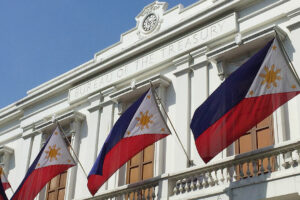NG debt hits record P12.68 trillion as of end-March

Since 2020, the Philippines borrowed P1.3 trillion and received grants worth P2.7 billion to fund its pandemic response, including coronavirus vaccines. — PHILIPPINE STAR/ MICHAEL VARCAS
By Tobias Jared Tomas
THE NATIONAL GOVERNMENT’S (NG) outstanding debt rose to a record P12.68 trillion as of end-March, as domestic and offshore borrowings increased, the Bureau of the Treasury (BTr) said on Thursday.
Preliminary data from the BTr showed that outstanding debt jumped by 17.73% from P10.77 trillion a year ago, and by 4.8% from February.
In a statement, the BTr said the higher debt was “primarily due to the net issuance of government securities to both local and external lenders.”
Of the total, 70% of the debt portfolio were from domestic lenders, while the rest were from foreign sources.
Domestic debt stock stood at P8.87 trillion as of end-March, up by 14.5% year on year, and 5.4% month on month. The National Government raised P457.80 billion through the successful domestic retail Treasury bond (RTB) issuance and debt exchange during the month.
Of the total domestic debt stock, P8.57 trillion was from government securities, up by 18.9% year on year and by 5.6% month on month.
As of end-March, the outstanding domestic debt was 8.5% or P698.24 billion more than the end-December level.
Meanwhile, external debt grew by 25.8% year on year to P3.81 trillion as of end-March. It inched up by 3.6% from February.
The Treasury attributed the higher external debt to the net availment of external financing that reached P122.69 billion as of end-March. This included P117.33 billion ($2.25 billion) that was raised from the issuance of the triple tranche 5-year, 10.5-year and 25-year global bonds.
“Third-currency exchange rate fluctuation further lowered the peso value of external guarantees by P5.16 billion, offsetting the P2.31-billion effect of local currency depreciation against the (US dollar),” it said.
Rizal Commercial Banking Corp. Chief Economist Michael L. Ricafort said in a Viber message that the government issued RTBs and global bonds to raise funds for various projects ahead of the election ban on public works that began on March 25.
“[The] rising trend in interest rates, with long-term interest rates at new pre-pandemic highs recently could increase interest payments for new borrowings,” he said.
Mr. Ricafort noted the debt level may reach new record highs in the coming months as the government needs to borrow funds to address the widening budget deficit.
In April, the government raised $559 million from a Samurai bond issuance, and tapped a 30-billion yen ($230-million) loan from Japan.
ING Bank N.V. Manila Senior Economist Nicholas Antonio T. Mapa said in an e-mail that the country might be vulnerable to credit rating actions as the total debt hit roughly 60.6% of gross domestic product (GDP) as of end-March.
“Fitch had previously expressed some concern about the ability of the Philippines to substantially lower this ratio over time,” he added.
In 2021, the Philippines’ debt-to-GDP ratio hit a 16-year high of 60.5%. This is higher than the 60% threshold considered manageable by multilateral lenders for developing economies.
The high level of debt leaves the incoming administration with “very limited options,” Ateneo de Manila University Economics Professor Leonardo A. Lanzona said via Viber.
“Politicians who promise unrealistic programs such as lower rice prices should be avoided… The first item in the agenda of the next administration is to design an economic program that will produce enough growth to pay for our debt,” he said.
“This can mean even larger debt, but the program should be credible enough to assure the financial agencies that we can eventually pay our debts.”
For his part, Mr. Mapa said that the current administration inherited a fairly healthy fiscal position, a luxury the incoming president will not have.
The next president would have to be careful in their decisions in their first 100 days in office, as investors will be watching if fiscal consolidation is a top priority, he said.
“If spending and borrowing continue to bloat the debt levels in the near term, we believe the Philippines will receive a credit downgrade by the end of the year, forcing up our borrowing costs when the Philippines would need to source funding,” Mr. Mapa said.
Fitch Ratings earlier in February maintained the Philippines’ “BBB” credit rating, but with a “negative” outlook, meaning that Fitch could downgrade this rating within 12 to 18 months.
Meanwhile, Mr. Ricafort stressed the need for the next administration to sustain the economic and fiscal reform measures.
Last month, Finance Secretary Carlos G. Dominguez III said the economy needs to grow above 6% annually in the next five to six years to reduce debt.
“The next administration would have to design policies and stick to very strict fiscal discipline to grow out of this debt problem,” he said.
The national election will be held on May 9, with the new administration taking over in July.
Since 2020, the Philippines borrowed P1.3 trillion and received grants worth P2.7 billion to fund its pandemic response, including coronavirus vaccines.
The Department of Finance has said it would take 40 years to pay off these pandemic-related loans and grants.




